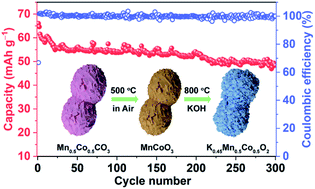Self-templated construction of peanut-like P3-type K0.45Mn0.5Co0.5O2 for highly reversible potassium storage†
Abstract
Potassium-ion batteries (PIBs) as energy storage devices show great development potential in the field of large-scale energy storage on account of their abundant potassium resources, rapid K+ mobility in electrolyte, and low potential of K. However, the commercial application of PIBs is greatly hindered by the shortage of suitable cathode materials that can withstand the stress arising from larger K+ (de)insertion. In this work, a layered P3-type K0.45Mn0.5Co0.5O2 cathode with a peanut-shaped hierarchical structure (denoted as p-KMCO) is synthesized via an elegant self-templating method for PIBs. Benefiting from the synergistic effect of the unique hierarchical architecture, it can reduce the contact area with the electrolyte, accelerate the K+ diffusion kinetics, and alleviate the structural strain arising from repetitive K+ insertion/extraction. As a result, the as-obtained p-KMCO delivers a high reversible capacity of 123.2 mA h g−1 at 20 mA g−1, improved rate capability of 66.8 mA h g−1 at 300 mA g−1, and long-term cycling stability (73.8% capacity retention over 300 cycles). Moreover, the p-KMCO//pitch-derived soft carbon K-ion full cell also exhibits satisfactory rate performance and cycling stability.



 Please wait while we load your content...
Please wait while we load your content...